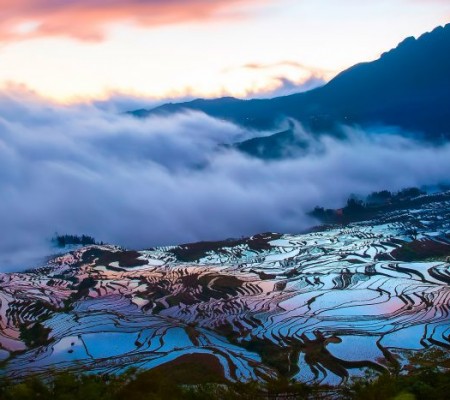
Puji Village of Shuhe Sub-district in Gucheng District, Lijiang
Geographical Location
Puji Village(普济村) is located in Zhongji Community, Shuhe Street, Gucheng District, Lijiang City, in the western mountainous area of the Lijiang Basin. Surrounded by mountains on all sides, the village enjoys beautiful scenery with an altitude of about 2400 meters and an annual average temperature of 12.6℃, making the climate pleasant. It is approximately 10 kilometers away from the Lijiang Ancient City. Driving along the Xishan Tourist Road from the city center, it takes only about 20 minutes to reach the village, which is conveniently accessible. The village is rich in natural resources, with fertile farmland and dense forests. Its moderate size provides favorable geographical conditions for village development and tourism. Additionally, it is only 600 meters away from the Puji Temple, one of the five major temples in Lijiang and the only surviving copper – roofed temple in Yunnan, making the religious cultural atmosphere particularly strong.
Ethnic Groups and Traditional Skills
Ethnic Composition (民族构成)
Puji Village is a multi – ethnic settlement where Naxi, Han, Tibetan, Bai, and other ethnic groups live together harmoniously. The village consists of 69 households with a total population of 289 people. The long – term interaction and integration of these ethnic groups have formed a unique and diverse regional culture.
Traditional Skills (传统技艺)
-
Naxi Handicraft Textile (纳西族手工纺织): Naxi women have inherited the ancient skill of handicraft textile – making. Using traditional wooden looms, they spin cotton grown locally or wool collected into yarn and weave it into cloth. During the weaving process, they incorporate techniques such as pattern – picking and embroidery to create auspicious patterns on the fabric, such as sun, moon, stars, flowers, birds, fish, and insects. These textiles are not only used for making daily clothing but also become handicrafts with a strong ethnic flavor.
-
Dongba Paper – making (东巴造纸): The Dongba paper – making process of the Naxi people is complex and delicate. It uses the local endemic Daphne genus plant, Daphne lichiangensis, and goes through many processes, including collection, drying, soaking, boiling, washing, pounding, paper – pouring, paper – sticking, and paper – drying. Dongba paper is strong and mothproof, serving as an important carrier for the inheritance of Dongba culture. It is often used for writing Dongba scriptures and drawing Dongba paintings. In Puji Village, a few craftsmen still master this skill.
-
Woodcarving (木雕工艺): The woodcarving skill, which integrates the characteristics of multiple ethnic groups, is very popular in Puji Village. Villagers select high – quality wood, such as azalea wood and walnut wood. After careful carving by craftsmen, various woodcarving works are produced. The patterns cover a wide range of topics, including myths and legends, historical stories, and natural scenery. The woodcarvings are not only used for architectural decoration, such as doors and windows and beams, but also made into woodcarving ornaments and pendants. The carving style is rough but delicate, with a strong ethnic flavor.
Customs and Festivals
Daily Customs
-
Dietary Customs (饮食习俗): The diet of Puji villagers integrates the characteristics of multiple ethnic groups. The main food consists of rice and noodles. Naxi dishes such as smoked pork ribs and baba, Bai dishes such as Three – Course Tea and raw pork, and Tibetan dishes such as butter tea and tsampa are also common on the villagers’ tables. In terms of dining etiquette, the Naxi tradition of respecting the elderly and honoring the elders is deeply rooted. Younger generations must wait for their elders to start eating before they can begin.
-
Living Customs (居住习俗): Influenced by the traditional architectural styles of various ethnic groups, the village features typical Naxi “Three Rooms and One Screen Wall” and “Four – Courtyard and Five Sky – wells” earth – wood – structure houses, Bai – style buildings with blue tiles, white walls, and upturned eaves, as well as Tibetan – style stone – wood – structure houses. The layout of the houses focuses on integration with the natural environment, with flowers and fruit trees planted in the courtyards to create a comfortable and pleasant living atmosphere.
Important Festivals
-
Sanduo Festival (三朵节): On the eighth day of the second lunar month every year, the Naxi people celebrate the grand Sanduo Festival to worship their ethnic protector god “Sanduo”. Naxi villagers in Puji Village dress in their finest clothes and go to the nearby Sanduo Temple to offer rich sacrifices, praying for favorable weather, abundant harvests, and prosperity of livestock. After the sacrifice, everyone gathers together to perform traditional dances such as Ali Li and Dajiao, creating a lively atmosphere.
-
Torch Festival (火把节): On the twenty – fourth day of the sixth lunar month, the Yi, Bai, and other ethnic groups jointly celebrate the Torch Festival. On that evening, every household sets up a tall torch in front of their door, made of pine torches and firewood, and decorated with colorful flags. As night falls, the torches are lit. Villagers hold small torches and parade around the big torch, chanting blessings. Subsequently, a grand bonfire party is held, with people singing and dancing around the bonfire, creating a spectacular scene.
-
Tibetan Buddhist Festivals (藏传佛教节日): Due to the deep connection with Tibetan Buddhism, important Tibetan Buddhist festivals such as the Butter Lamp Festival (on the twenty – fifth day of the tenth month in the Tibetan calendar) are also celebrated here with great enthusiasm. During the festival, villagers dressed in traditional costumes visit the temple, which is illuminated with numerous lamps. Lamas chant scriptures and offer blessings, while the public burn incense and turn prayer wheels. The atmosphere is solemn and full of religious fervor.
Ancient Architecture
Traditional Residences (传统民居)
Puji Village preserves a large number of traditional residences, showcasing the integration of multiple ethnic architectural styles. Naxi traditional residences are mostly earth – wood – structure houses, with a layout of “Three Rooms and One Screen Wall” or “Four – Courtyard and Five Sky – wells”. “Three Rooms and One Screen Wall” is composed of the main room, two side rooms, and a screen wall. The screen wall is usually built with bricks and stones and is decorated with beautiful patterns of landscapes and flowers and birds, which are both beautiful and functional for wind – blocking and lighting. The main room is tall and spacious, facing north to south, and serves as the center of family activities, while the side rooms are used for living or storing items. Bai residences are mainly characterized by blue tiles and white walls. The buildings have an elegant appearance, with upturned eaves and exquisite decorations. The doors, windows, and walls are adorned with exquisite woodcarvings, stone carvings, and color paintings, with a wide range of themes such as myths and legends, historical stories, and flowers and birds. These decorations show the Bai people’s superb architectural skills and aesthetic taste. Tibetan – style houses are mostly made of stone and wood. They have a thick and simple appearance, with colorful decorations on the doors and windows, showing a unique ethnic style.
Ancient Bridges and Roads (古老桥梁与道路)
There are some ancient bridges and roads in the village, which have witnessed the passage of time. These bridges are mostly stone or wooden bridges, with a simple structure but strong and durable, spanning over streams and facilitating villagers’ travel. The ancient stone – paved roads wind through the village, connecting every household, with marks on the stone slabs telling stories of the past. Some of the roads and bridges also integrate the architectural styles of multiple ethnic groups, having certain historical and cultural values.
Tourism Resources
Natural Scenery
-
Rural Landscape (田园风光): Puji Village is surrounded by vast and fertile farmlands with different scenery in each season. In spring, the fields are full of tender green wheat seedlings and fava bean seedlings, presenting a scene of vitality. In summer, the golden rapeseed flowers and plump rice panicles sway in the wind, showing the hope of harvest. In autumn, the rice fields are fragrant with a golden carpet covering the earth. In winter, although the farmland looks a bit desolate, the distant mountains and the farmland form a quiet ink – wash painting. Visitors can walk in the fields, participate in agricultural activities, and experience the fun of rural life.
-
Forest Landscape (山林景观): The surrounding area of the village has vast forest land with a high forest coverage rate and a wide variety of trees. Walking in the forest, you can breathe fresh air, admire various rare plants, and hear the cheerful songs of birds. There are also some clear streams in the forest, with gurgling water adding a touch of liveliness. In summer, it is an ideal place to cool off. In autumn, the mountains covered with red leaves are poetic and picturesque, attracting many photography enthusiasts.
-
Puji Temple Scenery (普济寺景观): Adjacent to the village, Puji Temple is a famous Buddhist temple in Lijiang. The copper – roofed hall in the temple is unique and shines brightly in the sunlight. The temple is surrounded by a quiet environment with towering ancient trees. Visitors can feel the strong religious atmosphere here, admire the exquisite Buddhist architecture and murals, and learn about Buddhist culture.
Cultural Scenery
-
Cultural Experience (民族文化体验): Visitors can delve into the homes of different ethnic groups to experience their daily lives. Learn traditional handicrafts such as handicraft textile – making, Dongba paper – making, and woodcarving, taste ethnic – specific cuisine, and feel the unique atmosphere of harmonious coexistence of multiple ethnic groups. The village also regularly holds cultural activities such as ethnic song and dance performances and traditional handicraft displays, in which visitors can actively participate to gain a deeper understanding of the local culture.
-
Ancient Architecture Tour (古建筑游览): Visit the traditional residences, ancient bridges, and roads in the village to appreciate the integration of multiple ethnic architectural styles and learn about their historical and cultural background. Some residences have been transformed into folk museums or guesthouses, where visitors can stay and experience a combination of tradition and modernity.
Leisure and Entertainment
-
Picking Experience (采摘体验): The fruit – growing industry in Puji Village and the surrounding areas is well – developed, with many orchards distributed around. During the fruit – ripening season, visitors can go to the orchards to participate in picking activities. They can pick fresh apples, pears, cherries, and other fruits by themselves, taste the sweetness of nature’s gifts, and experience the joy of harvest. Some orchards also offer farmhouse services, where visitors can enjoy the tranquility and comfort of the countryside while tasting farmhouse dishes.
-
Guesthouse Leisure (民宿休闲): With the development of rural tourism, a number of characteristic guesthouses have emerged around Puji Village. These guesthouses are mostly transformed from traditional residences, preserving the ethnic architectural style while being equipped with modern facilities. Visitors can relax in the guesthouse courtyard, drink tea, and enjoy the sunshine. They can also communicate with the guesthouse owners to learn about the local customs. Some guesthouses also offer special experience activities such as handicraft making and agricultural activities, making the trip more colorful.
-
Cultural Activity Experience (文化活动体验): Participate in cultural activities organized by Puji Village, such as ancient band performances, Ali Li song and dance performances, and hundred – person choirs. Feel the strong cultural atmosphere of the local area and enjoy happy times with villagers through singing and dancing.

 7 Days GolfingTour
7 Days GolfingTour
 8 Days Group Tour
8 Days Group Tour
 8 Days Yunnan Tour
8 Days Yunnan Tour
 7 Days Shangri La Hiking
7 Days Shangri La Hiking
 11 Days Yunnan Tour
11 Days Yunnan Tour
 6 Days Yuanyang Terraces
6 Days Yuanyang Terraces
 11 Days Yunnan Tour
11 Days Yunnan Tour
 8 Days South Yunnan
8 Days South Yunnan
 7 Days Tea Tour
7 Days Tea Tour
 8 Days Muslim Tour
8 Days Muslim Tour
 12 Days Self-Driving
12 Days Self-Driving
 4 Days Haba Climbing
4 Days Haba Climbing
 Tiger Leaping Gorge
Tiger Leaping Gorge
 Stone Forest
Stone Forest
 Yunnan-Tibet
Yunnan-Tibet
 Hani Rice Terraces
Hani Rice Terraces
 Kunming
Kunming
 Lijiang
Lijiang
 Shangri-la
Shangri-la
 Dali
Dali
 XishuangBanna
XishuangBanna
 Honghe
Honghe
 Kunming
Kunming
 Lijiang
Lijiang
 Shangri-la
Shangri-la
 Yuanyang Rice Terraces
Yuanyang Rice Terraces
 Nujiang
Nujiang
 XishuangBanna
XishuangBanna
 Spring City Golf
Spring City Golf
 Snow Mountain Golf
Snow Mountain Golf
 Stone Mountain Golf
Stone Mountain Golf




